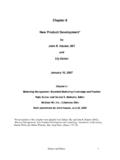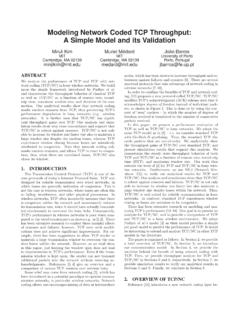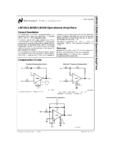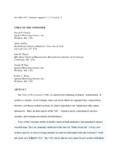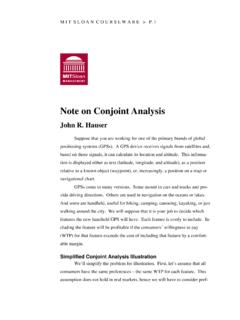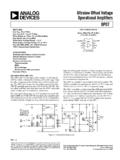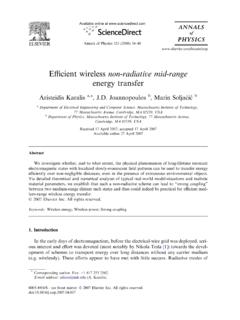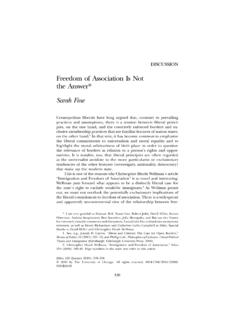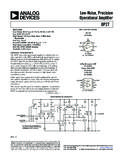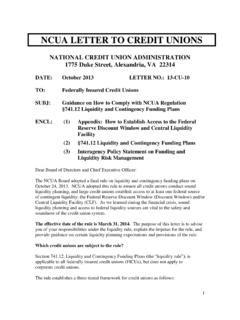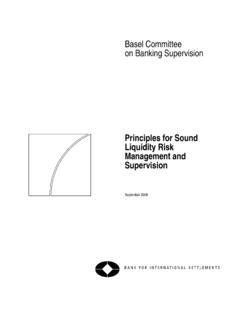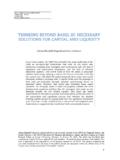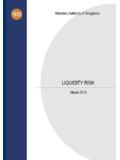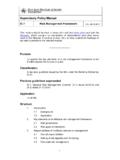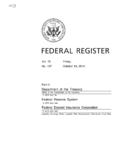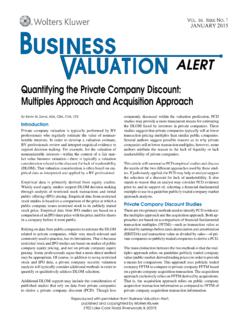Transcription of The Illiquidity of Corporate Bonds - mit.edu
1 The Illiquidity of Corporate BondsJack Bao, Jun Pan and Jiang Wang May 28, 2010 AbstractThis paper examines the Illiquidity of Corporate Bonds and its asset-pricing implicationsusing an empirical measure of Illiquidity based on the magnitude of transitory pricemovements. Relying on transaction-level data for a broad cross-section of corporatebonds from 2003 through 2009, we show that the Illiquidity in Corporate Bonds is sub-stantial, significantly greater than what can be explained by bid-ask spreads. We alsofind a strong commonality in the time variation of bond Illiquidity , which rises sharplyduring the 2008 crisis. More importantly, we establish a strong link between our illiquid-ity measure and bond prices, both in aggregate and in the cross-section.
2 In aggregate,we find that changes in the market level of Illiquidity explain a substantial part of thetime variation in yield spreads of high-rated (AAA through A) Bonds . During the 2008crisis, this aggregate Illiquidity component in yield spreads becomes even more impor-tant, over-shadowing the credit risk component. In the cross-section, we find that thebond-level Illiquidity measure explains individual bond yield spreads with large economicsignificance. Bao is from Ohio State University, Fisher College of Business Pan is from MITS loan School of Management, CAFR and NBER and Wang is from MIT Sloan School ofManagement, CAFR and NBER The authors thank Andrew Lo, Ananth Madhavan, KenSingleton, Kumar Venkataraman (WFA discussant) and participants at the 2008 JOIM Spring Conference,2008 Conference on Liquidity at University of Chicago, 2008 Q Group Fall Conference, 2009 WFA Meetings,and seminar participants at Columbia, Kellogg, Rice, Stanford, University of British Columbia, UC Berkeley,UC San Diego, University of Rhode Island, University of Wisconsin at Madison, Vienna Graduate School ofFinance, for helpful comments.
3 Support from the outreach program of Morgan is gratefully also thanks the Dice Center for financial IntroductionThe Illiquidity of the US Corporate bond markethas captured the interest and attention ofresearchers, practitioners and policy makers alike. The fact that Illiquidity is important inthe pricing of Corporate Bonds is widely recognized, but the evidence is mostly qualitativeand indirect. In particular, our understandingremains limited with respect to the relativeimportance of Illiquidity and credit risk in determining Corporate bond spreads and how theirimportance varies with market conditions. The financial crisis of 2008 has brought renewedinterest and a sense of urgency to this topic when concerns over both Illiquidity and creditrisk intensified at the same time and it was not clear which one was the dominating force indriving up the Corporate bond main objective of this paper is to provide a direct assessment on the pricing impactof Illiquidity in Corporate Bonds , at both the individual bond level and the aggregate that a sensible measure of Illiquidity is essential to such a task, we first usetransaction-level data of Corporate Bonds toconstruct a simple and yet robust measure ofilliquidity, , for each individual bond.
4 Aggregating this measure of Illiquidity across individualbonds, we find a substantial level of commonality. In particular, the aggregate illiquiditycomoves in an important way with the aggregate market condition, including market risk ascaptured by the CBOE VIX index and credit risk as proxied by a CDS index. Its movementduring the crisis of 2008 is also instructive. The aggregate Illiquidity doubled from its pre-crisis average in August 2007, when the credit problem first broke out, and tripled in March2008, during the collapse of Bear Stearns. By September 2008, during the Lehman defaultand the bailout of AIG, it was five times its pre-crisis average and over 12 standard deviationsaway. It peaked in October 2008 and then started a slow but steady decline that coincidedwith liquidity injections by the Federal Reserve and improved market the aggregate measure for Corporate Bonds , we set out to examine the relativeimportance of Illiquidity and credit risk in explaining the time variation of aggregate bondspreads.
5 We find that Illiquidity is by far the most important factor in explaining the monthlychanges in the US aggregate yield spreads of high-rated Bonds (AAA through A), with anR-squared ranging from 47% to 60%. Adding an aggregate CDS index as a proxy for aggregatecredit risk, we find that it also plays an important role, as expected, increasing the R-square by13 to 30 percentage points, but Illiquidity remains the dominant force. Despite the significantpositive correlation with the aggregate Illiquidity measure , the CBOE VIX index has noadditional explanatory power for aggregate bond spreads. We also find that while during nor-1mal times, aggregate Illiquidity and aggregate credit risk are equally important in explainingyield spreads of high-rated Bonds , with an R-squared of roughly 20% for Illiquidity alone anda combined R-squared of around 40%, Illiquidity becomes much more important during the2008 crisis, over-shadowing credit risk.
6 Thisis especially true for AAA-rated Bonds , whoseconnection to credit risk becomes insignificant when 2008 and 2009 data are included, whileits connection to Illiquidity increases significantly. Relating this observation to the discussionon whether the 2008 crisis was mainly a liquidity or credit crisis, our results suggest that asfar as high-rated Corporate Bonds are concerned, the sudden increase in Illiquidity was thedominating factor in driving up the yield that is constructed for individual Bonds , we further examine the pricing implicationof Illiquidity at the bond level. We find that explains the cross-sectional variation of bondyield spreads with large economic significance. Controlling for bond rating categories, weperform monthly cross-sectional regressions of bond yield spreads on bond Illiquidity andfind a positive and significant relation.
7 This relation persists when we control for credit riskusing CDS spreads. Our result indicates that for two Bonds in the same rating category, atwo standard deviation difference in their bond Illiquidity leads to a difference in their yieldspreads as large as 70 bps. Given that our sample focuses exclusively on investment-gradebonds, this magnitude of economic significanceis rather high. In contrast, other proxiesof Illiquidity used in previous analysis such asquoted bid-ask spreads or the percentage oftrading days are either insignificant in explaining the cross-sectional average yield spreads orshow up with the wrong sign. Moreover, the economic significance of remains robust in itsmagnitude and statistical significance after controlling for a spectrum of variables related tothe bond s fundamentals as well as bond characteristics.
8 In particular, other liquidity relatedvariables such as bond age, issuance size, and average trade size do not change this result ina significant empirical findings contribute to the existing literature in several important ways. Inevaluating the implication of Illiquidity on Corporate bond spreads, many studies focus onthe credit component and attribute the unexplained portion in Corporate bond spreads contrast, our paper uses a direct measure of Illiquidity to examine the pricing1 For example, Huang and Huang (2003) find that yield spreads for Corporate Bonds are too high to beexplained by credit risk and question the economic content of the unexplained portion of yield spreads. Colin-Dufresne, Goldstein, and Martin (2001) find that variables that should in theory determine credit spreadchanges in fact have limited explanatory power, and again question the economic content of the unexplainedportion.
9 Longstaff, Mithal, and Neis (2005) use CDS as a proxy for credit risk and find that a majorityof bond spreads can be attributed to credit risk and the non-default component is related to bond-specific2impact of Illiquidity in Corporate bond spreads, both in aggregate and in the cross-section. Weare able to quantify the relative importance of Illiquidity and credit and examine the extentto which it varied over time, including the 2008 also contribute to the existing literature by constructing a simple, yet robust measureof Illiquidity for Corporate Bonds . Several measures of Illiquidity have been examined inprevious work. One frequently used measure is the effective bid-ask spread, which is analyzedin detail by Edwards, Harris, and Piwowar (2007).
10 2 Although the bid-ask spread is a directand potentially important indicator of Illiquidity , it does not fully capture many importantaspects of liquidity such as market depth and resilience. Alternatively, relying on theoreticalpricing models to gauge the impact of Illiquidity allows for direct estimation of its influenceon prices, but suffers from potential mis-specifications of the pricing model. In constructing ameasure of Illiquidity , we take advantage of a salient feature of Illiquidity . That is, the lack ofliquidity in an asset gives rise to transitory components in its prices, and thus the magnitudeof such transitory price movements reflects the degree of Illiquidity in the price movements lead to negatively serially correlated price changes, the negativeof the autocovariance in relative price changes, which we denote by , gives a meaningfulmeasure of Illiquidity .
